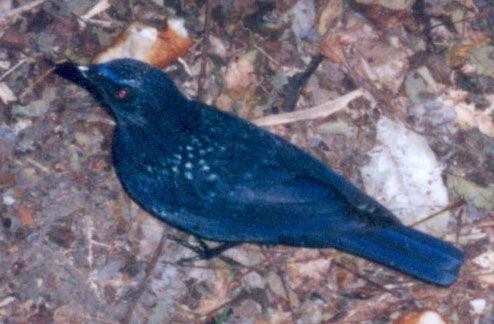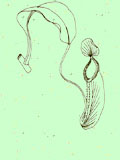
 |
Vertebrates (pdf)
The Ultraviolet Whistling Thrush and avian colour vision
The retinas of most birds have four different classes of cones, rather than the three we have in our retinas. Birds have visual pigments maximally sensitive in the red, green and blue parts of the spectrum, like us, plus an additional pigment that is most sensitive in either the violet (400-426 nm) or the ultraviolet (355-380 nm). Note that although the peak sensitivities differ between the two forms of the fourth pigment – called VS and UVS, respectively – they both permit birds to detect ultraviolet light. A number of experimental studies have now shown that birds use their ability to see UV in much the same way as they use other parts of the visual spectrum, i.e., for finding prey and for signaling to other members of their species. Birds are often more brightly coloured in the UV than they are in our visual range. The feathers of our familiar Violet (or Blue) Whistling Thrush (Myiophonus caeruleus), for example, display a peak reflectance at around 340 nm and they must appear much brighter to each other than they do to us (Prum et al., 2003). Other studies have shown that many fruits that appear black to human ecologists reflect strongly in the UV, and that these fruits become less attractive to frugivores if this UV signal is reduced (e.g. Altshuler, 2001). This presumably explains why "black", rather than the more conspicuous – to us - red, is the commonest fruit colour in Hong Kong (Corlett, 1996). Leaves and bark reflect little UV so a UV-bright fruit will be as conspicuous as a red one to a UV-sensitive bird. And it is not just fruit: both raptors (e.g. Koivula & Viitala, 1999) and shrikes (Probst et al., 2002) use the UV-reflecting scent marks of rodents to detect areas where they are active.
The only bird species occurring in Hong Kong that have been shown to have the UVS form are the Blackbird (Turdus merula), the Common Starling (Sturnus vulgaris), and the Pekin Robin (Leiothrix lutea), but it has also been found in non-Hong Kong species of tits (Parus), munias (Lonchura), leaf warblers (Phylloscopus) and gulls (Larus) (Ödeen & Håstad, 2003). More generally, it appears that most passerine birds have cones with peak sensitivity in the UV, with all exceptions so far being either crows (Corvus) or tyrannids. In contrast, all non-passerines tested, apart from gulls, parrots and the rhea, have had the violet-sensitive form of the cone pigment. Hong Kong species shown to have the VS form include several species of raptor, the Grey Heron (Ardea cinerea), the Little Ringed Plover (Charadrius dubius), the Black-winged Stilt (Himantopus himantopus), the Great Cormorant (Phalacrocorax carbo) and the Eurasian Coot (Fulica atra). The UVS/VS character state is controlled by a single nucleotide difference, so one would expect bird species to rapidly evolve whichever form is most adaptive, but we are still a long way from understanding what factors control this. If prey detection is the most important factor, why are gulls UV-sensitive and raptors violet-sensitive? Why are both character states found among frugivores, insectivores and granivores? Perception of the colour of an object depends not only on its reflectance properties, but also on the background colour(s) and the ambient light conditions, so predicting the most useful form is not easy.
 |
|
Fig. 1. The Ultraviolet Whistling Thrush (Myiophonus caeruleus) (Photo: Elsa Lee) |
Confused? Me too. Clearly, we have a long way to go before the evolution and ecology of bird vision is fully understood. It is also likely that studies on a wider range of bird species will show that the situation is even more complex than it appears at present. One lesson is clear, however: we cannot use what we see as a guide to the colour world perceived by birds. Indeed this is not only true for birds: many reptiles and fish, some amphibians and some rodents can see UV light, while most mammals lack red-sensitive cones and are thus red-green colour blind. Invertebrates have an even wider range of visual systems. Of all the thousands of animal species in Hong Kong, vertebrate and invertebrate, only the macaques see the world in the same way that we do.
Bibliography
Altshuler, D.L. (2001). Ultraviolet reflectance in fruits, ambient light composition and fruit removal in a tropical forest. Evolutionary Ecology Research 3: 767-778.
Corlett, R.T. (1996). Characteristics of vertebrate-dispersed fruits in Hong Kong. Journal of Tropical Ecology 12: 819-833.
Koivula, M. & Viitala, J. (1999). Rough-legged buzzards use vole scent marks to assess hunting areas. Journal of Avian Biology 30: 329-332.
Ödeen, A. & Håstad, O. (2003). Complex distribution of avian color vision systems revealed by sequencing the SWS1 opsin from total DNA. Molecular Biology and Evolution 20: 855-861.
Probst, R., Pavlicev, M. & Viitala, J. (2002). UV reflecting vole scent marks attract a passerine, the great grey shrike Lanius excubitor. Journal of Avian Biology 33: 437-440.
Prum, R.O., Andersson, S. & Torres, R.H. (2003). Coherent scattering of ultraviolet light by avian feathers. Auk 120: 163-170.
|
|
P.10-11 |
|
Porcupine! |
 Copyright © 2000 |
